By Joan Orendain
WREATHS will be laid, and taps resound through Intramuros, when Memorare Manila 1945 commemorates 29 deadly days in February 1945.
From Feb. 3 to March 3, 1945, 100,000 non-combatants died from Japanese atrocities: infants were tossed in the air and caught impaled on bayonets. Homes with their inhabitants locked within, were doused in gasoline and set to the torch, among many other unbelievable cruelties inflicted by the enemy on innocent Filipinos. Civilians fleeing the bloodbath to take cover at the Philippine General Hospital went waterless, with children having to drink their own pee to quench thirst.
Low on ammunition, the enemy sought various other ways to kill.
At its fiercest, Filipinos sought safe cover away from the Ermita-Malate area, the eye of the storm. Leopoldo Cu-unjieng who had ingeniously fashioned a “Red Cross flag” from towels on a pole, found himself leading a procession of dozens of Filipinos taking cover behind his flag.
Streets, rivers, and estuaries were littered with bodies by the time fighting ended on the 3rd of March.
Decades later sometime in 1993, Philippine Ambassador to Spain Juan Jose Rocha and two Zobel de Ayala relatives, Roderick McMicking Hall and his sister Connie McHugh, whose parents were killed in that period, got together to plan an annual commemoration of the 1945 atrocities, resulting in the formation of Memorare Manila 1945, led by Ambassador Rocha.
A lovely spot under calachuchi trees on the corner of Heneral Luna and Anda Streets in Intramuros, where the commemoration is held, was donated to Memorare, on which a striking sculpture of that terrible time was fashioned by Peter de Guzman. It is inscribed by National Artist Nick Joaquin.
This year, Memorare Manila 1945’s newly elected president, Marian Aboitiz, inheriting the mantle from her brother, Jose Miguel Cabarus, will lead Memorare, members of the diplomatic corps, other guests, and the Philippine Navy in observing that period. Japanese representatives of Bridge for Peace led by its founder, Naoko Jin, will also be in attendance. She will deliver a brief message. A short speech will also be delivered by Regalado Trota Jose, Chair of the National Historical Commission of the Philippines.
The public is invited to join the brief but stirring ceremony which starts at 8:30 a.m. on Saturday, Feb. 22.
